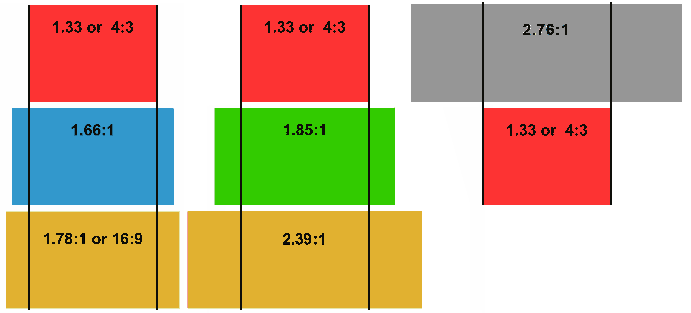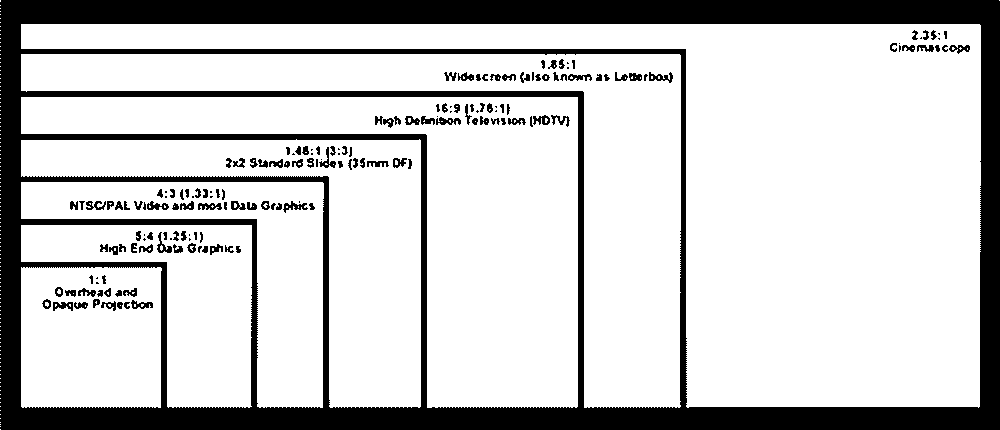Cinema Aspect Ratios
Aspect Ratio describes the visual size of an entertainment medium such as television or film in terms of the image's width compared to its height, usually expressed as x:y. The most common aspect ratios used today in the presentation of films in movie theaters are 1.85:1 and 2.39:1. Older television sets in the United States have a ratio of 4:3, meaning that the image you see is four units wide and three units tall. Widescreen televisions use 16:9, which is explained further in the Analog TV and Digital Video Resolution Guide.
- SDTV (4:3) or 1.33:1
- HDTV (16:9) or 1.78:1
- Cinema 2.35:1 and 1.85:1
Rather than refer to the whole number aspect 4:3, in cinematography terms these are reduced to decimal for the x side so that the y side is represented by 1. 1.33:1 in cinematography terms simplifies to 4:3, that is used in television terms.
The 4:3 ratio for standard television has been in use since television's origins and many computer monitors use the same aspect ratio. Since 4:3 is close to the old 1.37:1 cinema academy format, theaters suffered from a loss of viewers after films were broadcast on TV. To prevent this, Hollywood created widescreen aspect ratios to immerse the viewer in a more realistic experience and, possibly, to make broadcast films less enjoyable if watched on a regular TV set.
Aspect Ratios
| Format | Aspect Ratio | Aperture | X : Y | |
| mm | inch | |||
| 16 mm Film | 1.33 | 7.21 x 9.65 | 0.284 x 0.380 | 4 : 3 |
| 35 mm Film (before 1953) | 1.37 | 15.2 x 21 | 0.600 x 0.825 | 4 : 2.92 |
| 35 mm Film (USA) | 1.85 | 11.3 x 21 | 0.446 x 0.825 | 1.85 : 1 |
| 35 mm Film (Europe) | 1.65 | 12.7 x 21 | 0.500 x 0.825 | 1.65 : 1 |
| 35 mm Film (Anamorphic) | 2.35 | 17.8 x 21 | 0.702 x 0.825 | 2.35 : 1 |
| 70 mm Film | 2.21 | 22 x 48.6 | 0.868 x 1.913 | 2.21 : 1 |
| 35 mm Slide (Horizontal) | 1.48 | 22.9 x 34 | 0.902 x 1.340 | 4 : 2.7 |
| 35 mm Slide (Vertical) | 0.68 | 34 x 22.9 | 1.340 x 0.902 | 2.7 : 4 |
| A4 Paper | 1.41 | 210 x 297 | 4 : 2.83 | |
| '8 1/2 x 11' Paper | 1.30 | 215.7 x 279.4 | 8.5 : 11 | |
| Format | Aspect Ratio | Aperture/Resolution | X : Y | |
| mm | pixel | |||
| NTSC Video | 1.33 | 720 � 480 | 4 : 3 | |
| PAL Video | 1.33 | 4 : 3 | ||
| HDTV 720 | 1.78 | 1280 � 720 | 16 : 9 | |
| HDTV 1080 | 1.78 | 1920 � 1080 | 16 : 9 | |
| PAL Wide | 1.78 | 1024 � 576 | 16 : 9 | |
| Letterbox Video | 1.85 | 1.85 : 1 | ||
| "Widescreen" | 1.85 | 1.85 : 1 | ||
| Cinemascope | 2.35 | 2.35 : 1 | ||
| HDV-1 | 1.77 | 1280 x 720 | 16:9 | |
| HDV-2 | 1.77 | 1440 x 1080 | 16:9 | |
Cinema Formats
Academy Format
The first film format was developed in 1889 by Thomas Edison for his 'Kinetograph' using 35mm film, the picture format had a ratio of 1.37:1, the picture size was: width = 1 inch, height = 3/4 inch. The 'Academy Format' was established in 1932 with an aspect ratio of 1.33:1. This format was the de facto standard until 1953.
Cinerama Format
In 1928 the Cinerama Format was developed that used three 35mm film side by side to achieve the first wide screen format.
Cinerama 70mm
Developed in the 1960's with famous movies like produced films like A Space Odyssey, with an aspect ratio of 2.75:1, aperture dimensions: 1.912" x .0.870".
It was developed in 1953 and was copyrighted by 20th Century Fox. It produces a wide screen image with standard 35 mm film by using an anamorphic lens to 'boost' the displayed picture in the horizontal plane. The projected picture has an aspect ratio of 2.35:1. CinemaScope, or Panavision, is the most common format today and it will be the most common format until the worldwide change to Digital Cinema formats.
CinemaScope 55
Am alternative format by 20th Century Fox with the aspect ratio of 2.55:1, also using an anamorphic lens.
ArriScope-ArriVision
Designed by the Arriflex Camera Corporation with an aspect ratio of 2.35:1. It was used for two 3D feature films in 1983. The aperture dimensions are 0.864" x 0.732".
Imax
The IMAX format was developed in the early 1970's. 70mm film is projected horizontally, screens are 80 feet high. Famous for IMAX re-mastered movies were Star Wars Episode II Attack Of The Clones and Apollo 13.
Matted 1.66:1
Developed by Paramount in 1953 with an aspect ratio of 1.66:1. To achieve the wide format without an anamorphic lens, the top and bottom of the picture were masked.
Matted 1.85:1
Used by Universal and Columbia Pictures with the top and bottom masked to achieve an aspect ratio of 1.85:1.
Super 35mm
35mm film with wider optical sound track, without anamorphic lens, the picture is framed to fit the desired aspect ratio. Aspect ratio: variable, Standard 1.33:1, Widescreen 1.85:1, Panavision 2.35:1, aperture dimensions: 0.980" x 0.735".
SuperScope
Format developed in the 1950s, with anamorphic lens, two versions: aspect ratio of 2:1 and 2.35:1.
Developed in 1959, it was introduced by Panavision, Inc., aspect ratio: 2.2:1, aperture dimensions: 1.912" x .0.870".
Super Technirama 70mm
developed in the 1950s, aspect ratio: 2.35:1, aperture dimensions: 1.364" x .0.715".
Techniscope
Aspect ratio: 2.35:1
Technovision
Aspect ratio: 2.35:1
Developed in the 1950s, Aspect Ratio: 2.76:1, aperture dimensions: 2.072" x .0.906"
WarnerScope
Developed by Warner in the early 1950s, on 35mm film, aspect ratio: 2.35:1, aperture dimensions: 0.864" x 0.732".
Widescreen 1.85:1
Todays standard format with the aspect ration of 1.85:1,with optical stereo sound and/or Dolby Digital 5.1.
Related
See also Analog TV and Digital Video Resolution Guide.

